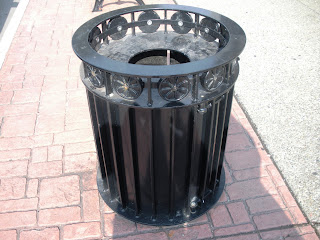GARBAGE CANS- PRESENT TIME
Use: Street garbage cans are usually placed in high travel areas and are used for encouraging people to throw away their trash. Trash cans provide a healthy alternative to littering and help to keep the Earth cleaner and healthier. The trash we throw away is taken to a landfill, incinerated, or recycled to make new products.
UB Trash Cans-
Scarborough design; bought from Landscape Forms, Inc.
Advertisement from seller: (Yes even trash cans need to sound appealing to the consumer!)
The Scarborough can is employed in active urban settings (such as UB) because of its aesthetic modern appearance and also because of its sustainability. These garbage cans go well with other street furniture. For example, these are usually paired with Scarborough benches made from the same company (Picture Below). These receptacles are made of recycled metal and are deemed by Landscape Forms to be 100% recyclable (Landscape Forms website)
Trash Cans from Main St.
Trash cans are considered street furniture. As with the furniture in your house you would ideally like it to match the other furniture. These next pictures are no exception to this idea. The first set of pictures I took was in front of Talking Leaves Bookstore. You can tell whose trash can this is when you look at the leaves painted on the can itself. They correspond to the leaves all over the Talking Leaves storefront.
These next images were taken near the Steer restaurant on Main St. near South Campus UB. The bench and the garbage can are actually manufactured by the same company. This is similar to the garbage cans and benches on North Campus UB.
A Trash Can From Miami
(Photo from <http://miamieverydayphoto.blogspot.com/2009_02_01_archive.html>)
This is a trash can from Miami, Florida. Now obviously the city doesn’t want these tipped over and trash thrown everywhere when a hurricane comes rolling through. That’s why these are made of concrete.
Interestingly enough Miami has one the most technologically advanced waste-to-energy plants in the world. It takes the trash we throw away and incinerates it to make energy for the equivalent of powering 40,000 homes. The trash that would normally go to the landfill then becomes only 10% of its normal volume in ash form and is dumped in to an ash landfill (http://www.miamidade.gov/dswm/).
Trash Cans From Elsewhere in the World
Japan
(Photo from <http://greenz.jp/en/2010/07/21/incineration-in-japan/>)
Garbage cans in a Japanese subway station. They are clear because it’s easier to detect things that should not be put in there (like bombs!)
The transparency safety effort has also been introduced in other cities throughout the world such as Paris, France.
On an interesting side note, from what I have poked around on the web about trash cans around the world, Japan seems to be the only place that I have encountered people complaining about the scarcity of public trash cans (http://new2japan.com/garbage/).
Amstelveen, The Netherlands
(Photo from <http://www.expatcenter.info/aspx/read.aspx?xdl=/views/amsterdamnl/xdl/page&VarIdt=186&ItmIdt=126512>)
Paris, France
(Photo from <http://commons.wikimedia.org/wiki/File:Waste_Container_Plastic_Bag_Paris_.jpg>)
Lausanne, Switzerland
(Photo from <http://commons.wikimedia.org/wiki/File:Recycling_bin_Lausanne_mp3h7756.jpg>)
Taipei, Taiwan
(Photo from <http://commons.wikimedia.org/wiki/File:Taiwan_2009_Taipei_Waste_Containers_throughout_Liberty_Plaza_with_National_Theater_in_background_FRD_7440.jpg>)
Other Present Uses for Trash Cans:
Advertisements-
A way to get the word out about your company or to get your name out to voters.
(Photo from <http://www.brooklynpaper.com/stories/31/38/31_38_sp_yassky_cans.html>)
Food Sources-
We would not eat this stuff but it makes great food for some animals.
(Photo from <http://commons.wikimedia.org/wiki/File:Raccoon_getting_in_trouble.jpg>)
(Photo from <http://www.alaska-in-pictures.com/bear-with-garbage-can-4134-pictures.htm>)
THE FUTURE OF GARBAGE CANS
Solar Powered Trash Compactors
(Photo from <http://www.phillydesignblog.com/2009/05/big-belly/>)
Solar powered trash compactors are already in use by cities like Philadelphia, PA, Pasadena, CA and even universities such as Georgetown University and Arizona State University
Why?
Because these are easy to use and compact the trash inside so that waste removal doesn’t need to happen as often. Therefore municipalities save money that they can use toward other city projects. As Liisa Rajala, from USA TODAY explains it: “A growing number of cities and municipalities are testing solar-powered trash compactors as a way to go green and save some green” (<http://bigbellysolar.com/usa-today-trash-cans-dumped-for-sun-powered-compactors/>)
How do they work?
When the bin inside gets full, the compactor crushes the garbage inside and makes room for more trash. When this can reaches its full capacity it sends a text message, via its wireless capability, to the department in charge of picking up this bin. This is all done using solar power.
Self-Emptying Pnuematic Trash Cans
(Photo from <http://gellersworldtravel.blogspot.com/2010/06/shanghai-expo-2010-few-more-photos.html>)
These “green” trash cans take the collection problem out of recycling. They are designed to pump garbage via underground tubes to the recycling station nearby and eliminate the need for trash pickup all together. These are planned to be used at the Shanghai World Expo 2010 which currently runs from May 2010 to October 2010 and where the theme is “Better City, Better Life” (<http://english.cri.cn/6909/2010/01/22/195s544411.htm>).
Of course these are great for the environment, but one of the main concerns about these new pneumatic trash cans is that they pose a threat to the men and women who come to pick up the trash we throw out. Like robots in car factories people again will be replaced by technology.

















No comments:
Post a Comment